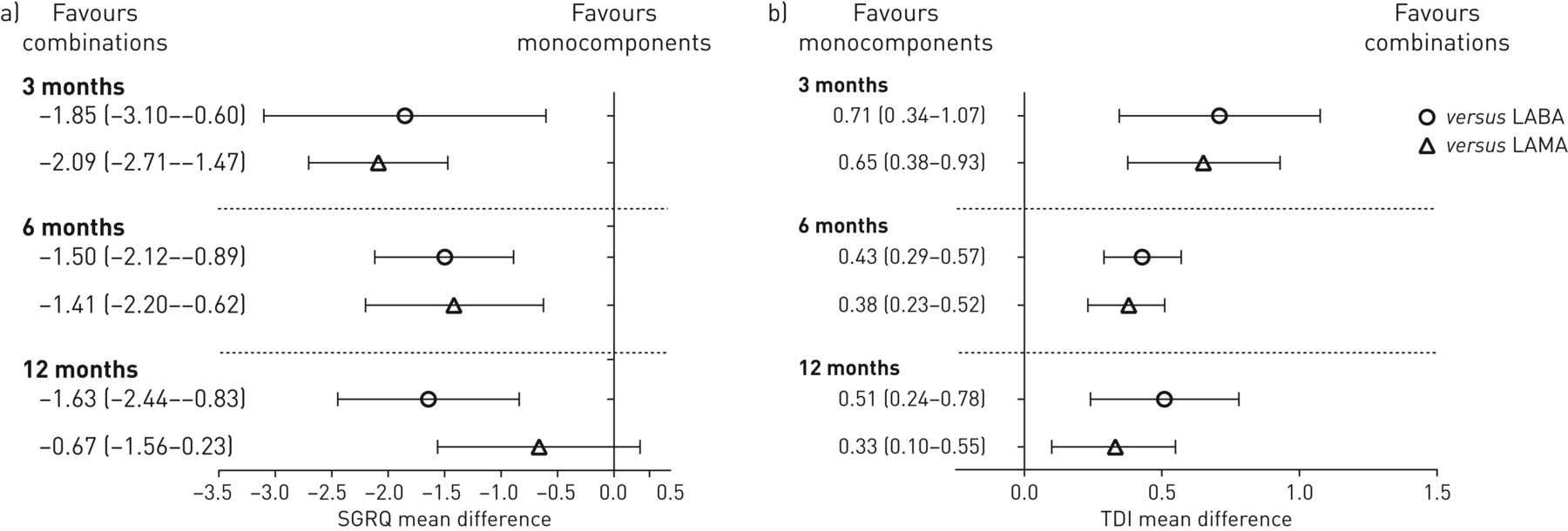

Long-acting bronchodilators are the basis of treatment of chronic obstructive pulmonary disease (COPD). Initiation of treatment with LABA/LAMA was associated with a lower risk of exacerbation and escalation to triple therapy compared to LABA/ICS in the majority of patients with COPD in primary care. LABA/LAMA was associated with a significantly lower risk of exacerbations and escalation to triple therapy compared to LABA/ICS, except in patients with frequent exacerbations and high blood eosinophils in which no differences were observed in the time to first exacerbation. Similar results were obtained in the matched population. The time to scalation to triple therapy was also significantly prolonged in LABA/LAMA. The mean time to the first exacerbation was 6.03 months (95% confidence interval (CI): 5.94–6.12) for LABA/ICS and 6.4 months (95%CI: 6.21–6.59) for LABA/LAMA p < 0.001. During follow-up, 69.6% patients in the LABA/ICS group and 64.4% in the LABA/LAMA group presented an exacerbation. The matched population included 1650 patients in each arm. The population consisted of 14,046 COPD patients 11,329 (80.6%) initiated LABA/ICS and 2717 (19.4%) LABA/LAMA. A sensitivity analysis was conducted in a propensity-score matched population. The primary outcome was the risk of first exacerbation. Data were obtained from an administrative healthcare claims database. We performed a retrospective, population-based, observational study aimed at comparing the effectiveness of a LABA/long-acting antimuscarinic agent (LAMA) and LABA/ICS in patients with COPD over a one-year follow-up. Initiation of treatment of COPD with a combination of a long-acting beta-agonist (LABA) and an inhaled corticosteroid (ICS) is frequent irrespective of the risk of exacerbations. The Journal expresses the voice of the Spanish Respiratory Society of Pulmonology and Thoracic Surgery (SEPAR) as well as that of other scientific societies such as the Latin American Thoracic Society (ALAT) and the Iberian American Association of Thoracic Surgery (AICT).Īuthors are also welcome to submit their articles to the Journal's open access companion title, Open Respiratory Archives. Furthermore, the Journal is also present in Twitter and Facebook. Manuscripts will be submitted electronically using the following web site:, link which is also accessible through the main web page of Archivos de Bronconeumologia.Īccess to any published article, is possible through the Journal's web page as well as from PubMed, Science Direct, and other international databases. The Journal is published monthly in English. It is a monthly Journal that publishes a total of 12 issues and a few supplements, which contain articles belonging to the different sections.Īll the manuscripts received in the Journal are evaluated by the Editors and sent to expert peer-review while handled by the Editor and/or an Associate Editor from the team. Other types of articles such as reviews, editorials, a few special articles of interest to the society and the editorial board, scientific letters, letters to the Editor, and clinical images are also published in the Journal. Archivos de Bronconeumologia is a scientific journal that preferentially publishes prospective original research articles whose content is based upon results dealing with several aspects of respiratory diseases such as epidemiology, pathophysiology, clinics, surgery, and basic investigation.


 0 kommentar(er)
0 kommentar(er)
